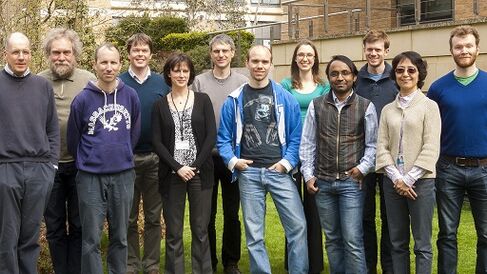Laue Group

Welcome to the Laue Group Website!
Embryonic stem (ES) cells either self-renew or differentiate into all the different cells in a body. Our research is focussed on studies of two key protein complexes, CAF-1 and NuRD.
Chromatin Assembly Factor-1 (CAF-1) assembles histones H3/H4 into DNA in the first step of nucleosome assembly, and its depletion converts ES cells into a state similar to that of the two-cell state in embryonic development. The multi-subunit nucleosome remodelling and deacetylase (NuRD) protein complex, which deacetylates H3/H4 shortly after their deposition, plays a central role in ES cell differentiation by controlling the expression of specific pluripotency-associated genes. It also has an important role in controlling the generation of induced pluripotent stem (iPS) cells.
We use single-molecule super-resolution fluorescence microscopy to directly image proteins involved in chromatin assembly. This uses molecular and cell biological techniques to tag particular proteins with photo-activatable fluorophores in order to study them in both live and fixed cells at the single-molecule level at near molecular resolution. At the same time, we use data from biochemical cross-linking and high-throughput sequencing to determine the in-vivo 3D chromosome structure in single cells.
To understand how the NuRD complex modulates chromatin structure and gene expression we have combined these methods to study the global structure of chromatin within single cells. We have used this approach to calculate 3D structures of the intact genome in haploid embryonic stem cells (Stevens et al.,Nature, 2017) and the structures are providing hypotheses regarding the function of the NuRD complex in regulating chromatin structure. We are also developing single-molecule microscopy to study the assembly of nuclear complexes in live cells (Basu et al., Nature Commun., 2018).
In parallel, we are also carrying out structural studies of the NuRD complex. This involves the expression of both the intact complex and its sub-complexes using the baculovirus system in insect cells, and using electron microscopy, chemical cross-linking/mass spectrometry and biophysical methods to study the purified complexes.
Our research is currently funded by the Medical Research Council and the Wellcome Trust.
Local and external collaborators:
Local: Brian Hendrich (CSCR), David Klenerman (Chemistry), Tim Stevens (MRC-LMB), Ashwin Seshia (Engineering)
External: Imre Berger (Bristol), Christiane Berger-Schaffitzel
(Bristol), Tony Carr (Sussex), Xiuxia Du (North Carolina, USA), Ulrike Endesfelder (MPI Marburg, Germany), Opher Gileadi (SGC, Oxford), Mike Heilemann (Frankfurt, Germany), Alex Leitner (Zurich, Switzerland), David Norman (Dundee), Tom Owen-Hughes (Dundee), Frank Sobott (Antwerp, Belgium), Markus Sauer (Würzburg, Germany), Anton Wutz (CSCR, Cambridge and Zurich, Switzerland)
Applications:
We welcome applications from prospective PhD students and post-doctoral researchers.
